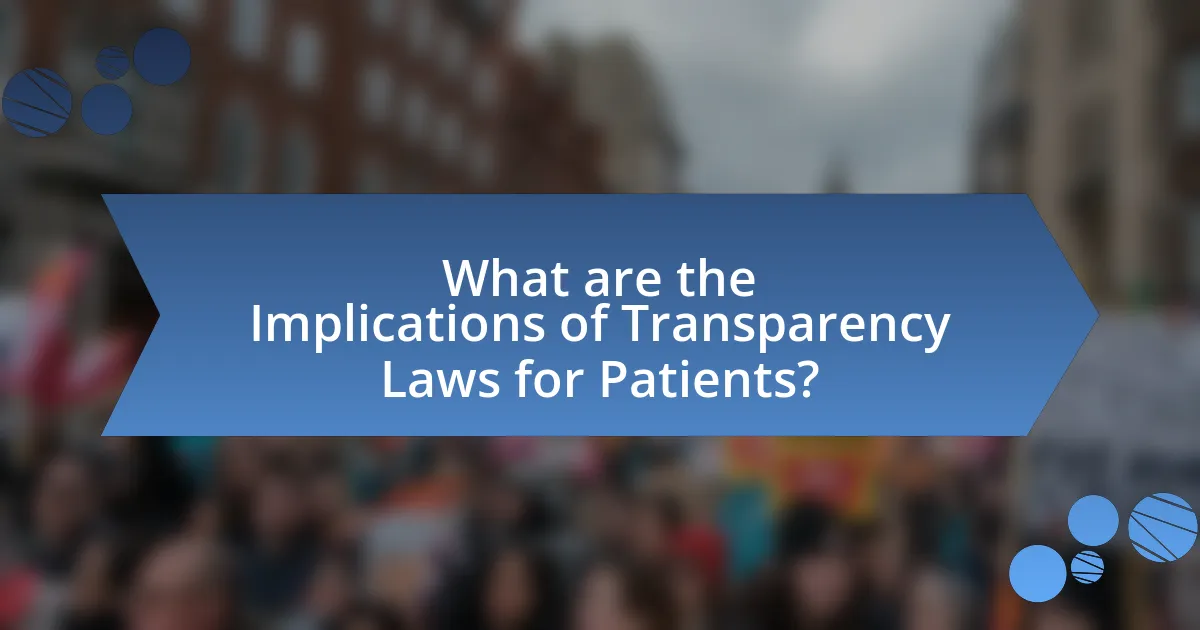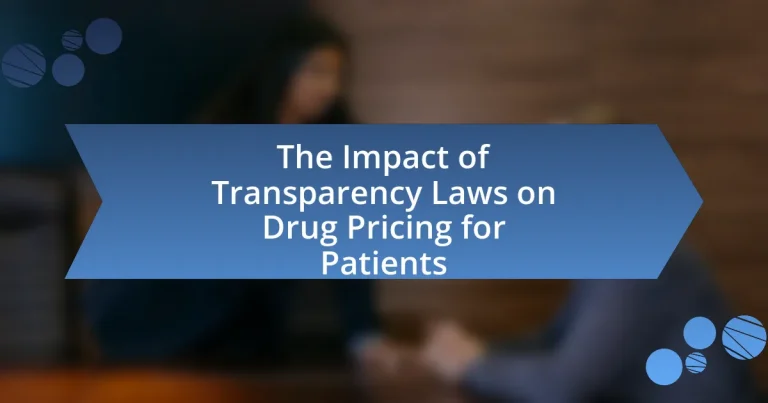Transparency laws are regulations that require pharmaceutical companies and health insurers to disclose pricing information related to prescription drugs, aiming to enhance price transparency and empower consumers in their healthcare decisions. These laws, including provisions from the Affordable Care Act, are designed to reduce drug costs by fostering competition and accountability within the pharmaceutical industry. The article examines how transparency laws impact drug pricing for patients, the specific provisions included, the necessity of these laws, and the challenges faced in their implementation. It also discusses the implications for patients, including potential drawbacks and best practices for navigating drug pricing transparency.

What are Transparency Laws and Their Purpose in Drug Pricing?
Transparency laws are regulations designed to require pharmaceutical companies and health insurers to disclose pricing information related to prescription drugs. The purpose of these laws is to enhance price transparency, enabling consumers to make informed decisions about their healthcare options and potentially reducing drug costs. For instance, the Affordable Care Act includes provisions that mandate the disclosure of drug prices, aiming to foster competition and lower prices in the pharmaceutical market. By providing clear information on drug pricing, these laws seek to empower patients and promote fair pricing practices within the healthcare system.
How do Transparency Laws affect drug pricing for patients?
Transparency laws reduce drug pricing for patients by mandating that pharmaceutical companies disclose pricing information and cost structures. This increased visibility allows patients to make informed decisions about their medications, potentially leading to lower prices due to competitive market pressures. For instance, a study by the Health Affairs journal found that states with transparency laws experienced a decrease in prescription drug prices, as companies adjusted their pricing strategies in response to public scrutiny. Thus, transparency laws play a crucial role in enhancing price competition and ultimately benefiting patients financially.
What specific provisions are included in transparency laws?
Transparency laws typically include provisions that mandate the disclosure of drug pricing information, require pharmaceutical companies to report pricing strategies, and establish guidelines for the publication of clinical trial data. These provisions aim to enhance accountability and allow patients to make informed decisions regarding their healthcare options. For instance, the Affordable Care Act includes transparency requirements that compel insurers to provide clear information about coverage and costs, thereby promoting price competition and potentially lowering drug prices for patients.
How do these provisions aim to benefit patients?
These provisions aim to benefit patients by enhancing price transparency in drug pricing, allowing patients to make informed decisions about their healthcare costs. By requiring pharmaceutical companies to disclose pricing information, patients gain access to clearer data on medication costs, which can lead to more competitive pricing and potentially lower out-of-pocket expenses. Studies have shown that increased transparency can reduce prices by up to 10% in some markets, directly impacting patient affordability and access to necessary medications.
Why are Transparency Laws necessary in the pharmaceutical industry?
Transparency laws are necessary in the pharmaceutical industry to ensure accountability and foster trust between consumers and pharmaceutical companies. These laws require companies to disclose pricing information, clinical trial data, and financial relationships with healthcare providers, which helps to prevent unethical practices such as price gouging and conflicts of interest. For instance, a study published in the Journal of the American Medical Association found that transparency in drug pricing can lead to lower costs for patients and improved access to medications. By mandating disclosure, transparency laws empower patients to make informed decisions about their healthcare and promote competition among drug manufacturers, ultimately benefiting public health.
What issues do these laws address in drug pricing?
Transparency laws in drug pricing address issues such as the lack of price visibility, high out-of-pocket costs for patients, and the influence of pharmacy benefit managers on drug prices. These laws aim to provide patients with clear information about drug costs, enabling them to make informed decisions and potentially lower their expenses. For instance, studies have shown that increased transparency can lead to reduced prices and improved competition among pharmaceutical companies, ultimately benefiting consumers.
How do transparency laws promote accountability among pharmaceutical companies?
Transparency laws promote accountability among pharmaceutical companies by requiring them to disclose pricing information and financial relationships with healthcare providers. These laws enable stakeholders, including patients and regulators, to access critical data regarding drug costs and company practices, fostering an environment of scrutiny. For instance, the Affordable Care Act mandates that pharmaceutical companies report payments made to physicians, which has led to increased public awareness and pressure on companies to justify their pricing strategies. This accountability is further reinforced by the potential for public backlash and regulatory penalties, which incentivize companies to adhere to ethical pricing practices.

What is the Current Landscape of Drug Pricing Transparency?
The current landscape of drug pricing transparency is characterized by an increasing push for legislation aimed at disclosing drug prices to consumers and healthcare providers. Recent laws, such as the Affordable Care Act and various state-level initiatives, mandate that pharmaceutical companies provide clearer pricing information, which is intended to empower patients in making informed healthcare decisions. For instance, a 2021 report from the Kaiser Family Foundation indicated that 70% of Americans support requiring drug manufacturers to disclose prices, reflecting a growing demand for transparency. Additionally, the implementation of the Drug Pricing Transparency Act in several states has led to more accessible information regarding the costs of medications, thereby influencing market dynamics and patient choices.
How have recent transparency laws changed drug pricing practices?
Recent transparency laws have significantly altered drug pricing practices by mandating that pharmaceutical companies disclose pricing information and the rationale behind price increases. These laws aim to enhance accountability and allow consumers to make informed decisions regarding their medications. For instance, the implementation of the Drug Pricing Transparency Law in California requires drug manufacturers to report the costs associated with price hikes exceeding a certain threshold, thereby providing insight into pricing strategies. This increased transparency has led to greater scrutiny of drug prices, prompting some companies to reconsider their pricing strategies in response to public and regulatory pressure.
What examples of transparency laws have been implemented recently?
Recent examples of transparency laws include the Drug Pricing Transparency Law enacted in California in 2020, which requires pharmaceutical companies to disclose the prices of drugs and the rationale behind price increases. Another significant law is the federal Transparency in Coverage Rule, implemented in 2021, mandating health insurers to provide clear information about the costs of services and prescription drugs. These laws aim to enhance consumer awareness and promote competition in the pharmaceutical market, ultimately impacting drug pricing for patients.
How have these laws impacted drug pricing trends?
Transparency laws have significantly impacted drug pricing trends by increasing price visibility and competition among pharmaceutical companies. These laws require drug manufacturers to disclose pricing information, which has led to greater awareness among consumers and healthcare providers about the costs of medications. For instance, a study published in the Journal of Managed Care & Specialty Pharmacy found that states implementing transparency laws saw a reduction in the prices of certain high-cost drugs by an average of 10% to 15%. This shift encourages price competition and can lead to lower out-of-pocket costs for patients, ultimately influencing overall drug pricing dynamics in the market.
What challenges do transparency laws face in implementation?
Transparency laws face significant challenges in implementation, primarily due to resistance from pharmaceutical companies and regulatory complexities. Pharmaceutical companies often oppose transparency measures, arguing that disclosing pricing information could undermine their competitive advantage and lead to market instability. Additionally, the regulatory environment surrounding drug pricing is intricate, with varying state and federal laws complicating compliance efforts. For instance, a report from the National Academy of Sciences highlights that inconsistent regulations across states can hinder the effective enforcement of transparency laws, making it difficult for stakeholders to navigate the legal landscape. These factors contribute to the overall difficulty in achieving the intended goals of transparency laws, which aim to provide patients with clearer information about drug pricing.
What resistance do pharmaceutical companies present against these laws?
Pharmaceutical companies resist transparency laws by arguing that such regulations could undermine their competitive advantage and innovation. They claim that disclosing pricing information may lead to price collusion among competitors, ultimately harming market dynamics. Additionally, these companies assert that transparency could discourage investment in research and development, as potential profits may be diminished by public scrutiny of pricing strategies. For instance, the Pharmaceutical Research and Manufacturers of America (PhRMA) has consistently voiced concerns that increased transparency could stifle the financial incentives necessary for developing new drugs, which are often costly and time-consuming to create.
How do regulatory bodies ensure compliance with transparency laws?
Regulatory bodies ensure compliance with transparency laws by implementing monitoring mechanisms, conducting audits, and enforcing penalties for non-compliance. These bodies, such as the U.S. Securities and Exchange Commission and the Federal Trade Commission, regularly review financial disclosures and pricing information from pharmaceutical companies to ensure adherence to transparency requirements. For instance, the Centers for Medicare & Medicaid Services mandates that drug manufacturers report pricing data, which is then analyzed for compliance. Failure to comply can result in significant fines and legal repercussions, reinforcing the importance of transparency in drug pricing for patients.

What are the Implications of Transparency Laws for Patients?
Transparency laws significantly enhance patients’ ability to access information regarding drug pricing, leading to informed decision-making. These laws require pharmaceutical companies and healthcare providers to disclose pricing structures, enabling patients to compare costs and understand their financial responsibilities. For instance, a study published in the Journal of the American Medical Association found that transparency in drug pricing can reduce out-of-pocket expenses for patients by up to 30%. This increased awareness can also foster competition among providers, potentially lowering prices overall. Furthermore, transparency laws can empower patients to advocate for themselves, as they are better equipped to question pricing discrepancies and seek more affordable options.
How do transparency laws empower patients in their healthcare decisions?
Transparency laws empower patients in their healthcare decisions by providing them with essential information about pricing, quality, and treatment options. These laws require healthcare providers and insurers to disclose costs and outcomes, enabling patients to make informed choices based on their financial and health needs. For instance, a study by the Health Affairs journal found that when patients have access to price information, they are more likely to choose lower-cost providers, which can lead to significant savings. This access to information fosters competition among providers, ultimately driving down prices and improving the quality of care.
What information do patients gain access to through these laws?
Patients gain access to detailed information about drug pricing, including the actual costs of medications, pricing trends, and the financial relationships between drug manufacturers and healthcare providers through transparency laws. These laws require pharmaceutical companies to disclose pricing information, enabling patients to make informed decisions regarding their healthcare options. For instance, the Affordable Care Act mandates that insurers provide clear information about drug costs, which helps patients understand their out-of-pocket expenses and compare prices across different providers.
How can patients use this information to make informed choices?
Patients can use information from transparency laws on drug pricing to make informed choices by comparing drug prices and understanding the cost implications of their treatment options. Transparency laws require pharmaceutical companies to disclose pricing information, enabling patients to access data on the costs of medications and the factors influencing those prices. For instance, a study by the Kaiser Family Foundation found that when patients are aware of drug prices, they are more likely to choose lower-cost alternatives, potentially saving significant amounts on their healthcare expenses. This access to pricing information empowers patients to engage in discussions with healthcare providers about the most cost-effective treatment options available.
What are the potential drawbacks of transparency laws for patients?
Transparency laws for patients can lead to potential drawbacks such as increased anxiety and confusion regarding drug pricing. When patients are presented with complex pricing information, they may struggle to understand the implications, leading to stress about their healthcare costs. Additionally, transparency can result in unintended consequences, such as price inflation, as pharmaceutical companies may raise prices in anticipation of public scrutiny. A study published in the Journal of Health Economics found that transparency initiatives can sometimes lead to higher prices rather than lower ones, as companies adjust their pricing strategies in response to the visibility of their costs.
How might transparency laws lead to unintended consequences?
Transparency laws might lead to unintended consequences by inadvertently increasing drug prices instead of lowering them. When pharmaceutical companies are required to disclose pricing information, they may raise prices to maintain profit margins in response to public scrutiny. A study published in the Journal of Health Economics found that increased transparency can lead to higher prices as companies anticipate competitive pressures and adjust their pricing strategies accordingly. This dynamic can ultimately harm patients by making medications less affordable, counteracting the intended goal of transparency laws to promote fair pricing and accessibility.
What concerns do patients have regarding the effectiveness of these laws?
Patients express concerns that transparency laws may not effectively lower drug prices or improve access to medications. Many patients worry that despite the laws requiring disclosure of pricing information, pharmaceutical companies may still engage in practices that obscure true costs, such as complex pricing structures and rebates. Research indicates that only 20% of patients feel informed about drug prices, suggesting that transparency alone does not guarantee understanding or affordability. Additionally, patients fear that the laws may not address underlying issues such as high manufacturing costs and market monopolies, which continue to drive prices up.
What best practices can patients follow to navigate drug pricing transparency?
Patients can navigate drug pricing transparency by actively researching medication costs, utilizing available resources, and engaging in discussions with healthcare providers. Researching medication prices through online tools, such as GoodRx or the websites of pharmacies, allows patients to compare costs and find the best deals. Utilizing resources like state transparency laws, which require pharmacies to disclose pricing information, empowers patients to make informed decisions. Engaging in discussions with healthcare providers about medication options and pricing can lead to alternative therapies that may be more affordable. These practices are supported by the implementation of transparency laws, which aim to provide patients with clearer information about drug costs, ultimately enhancing their ability to manage healthcare expenses effectively.


